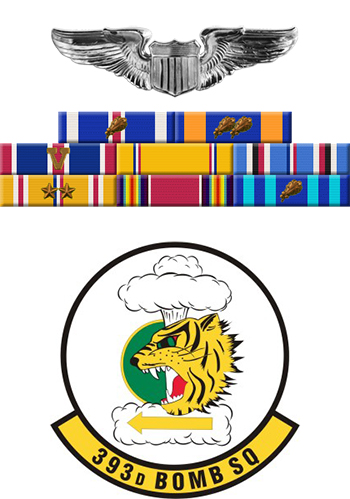
|
Frederick C. Bock, PhD |
 |
|||
| Rank, Service | ||||
Major O-4, U.S. Air Force |
||||
| Veteran of: | ||||
|
||||
| Tribute: | ||||
Frederick Bock was born on January 18, 1918, in Greenville, Michigan. He graduated with a bachelor's degree in Literature from the University of Chicago in 1939, and attended a year of post graduate school in Philosophy at the University of Chicago before enlisting in the Aviation Cadet Program of the U.S. Army Air Forces on July 11, 1941. Bock attended Primary Flying Training at Santa Maria Army Airfield, California, from July to October 1941; Basic Flying Training at Moffett Field, California, from October to December 1941; and Advanced Flying Training at Stockton Field, California, from December 1941 until he was awarded his pilot wings and commissioned a 2d Lt in the U.S. Army Air Forces on February 23, 1942. His first assignment was as a B-17 Flying Fortress pilot with the 18th Bomb Squadron of the 34th Bomb Group at Pendleton Field, Oregon, from February to April 1942, followed by service as a B-17 and B-24 Liberator pilot with the 436th Bomb Squadron of the 7th Bomb Group in India from April 1942 to August 1943. Lt Bock then returned to the United States and served as a B-17, B-24, B-25 Mitchell, and B-26 Marauder pilot with the 430th Bomb Squadron of the 9th Bomb Group and Army Air Forces Tactical Center at Orlando Army Air Base, Florida, from September 1943 to February 1944. Capt Bock next served as a B-29 Superfortress pilot with the 99th Bomb Squadron of the 9th Bomb Group at Dalhart Army Air Field, Texas, from March to May 1944, followed by service as a B-29 pilot at Clovis Army Airfield, New Mexico, during May 1944. He then served as a B-29 pilot with the 393rd Bomb Squadron of the 504th Bomb Group and then 509th Composite Group as it was stationed at Fairmont Army Airfield, Nebraska, from May to September 1944; at Wendover Field, Utah, from September 1944 to June 1945; deployed to North Field, Tinian, in the Pacific Theater from July to September 1945; and then at Roswell Army Airfield, New Mexico, from September 1945 to February 1946. During this time he served as Aircraft Commander of the B-29 "The Great Artiste" as the observation/instrument plane on the mission to drop the second atomic bomb on Nagasaki on August 9, 1945. His regular aircraft, "Bockscar", which was named for him, was used that day to drop the atomic bomb. Maj Bock left active duty and joined the Air Force Reserve on February 14, 1946, and he was honorably discharged from the Air Force Reserve on April 1, 1953. After leaving active duty he completed his PhD in Genetics and Statistics at the University of Chicago in 1950, and worked as a researcher until his retirement in 1986. Frederick Bock Flew West on August 25, 2000, and was buried at Forest Home Cemetery in Greenville, Michigan. |
||||
|
||||

